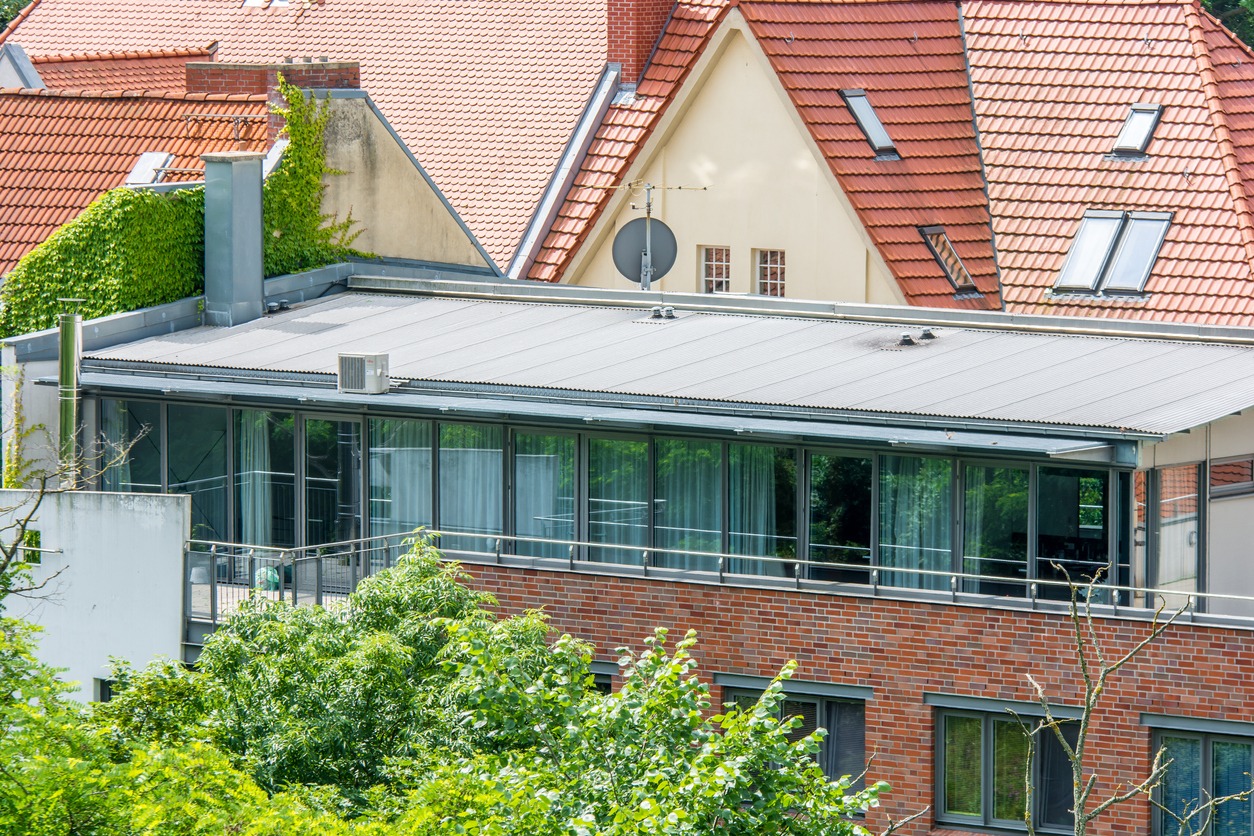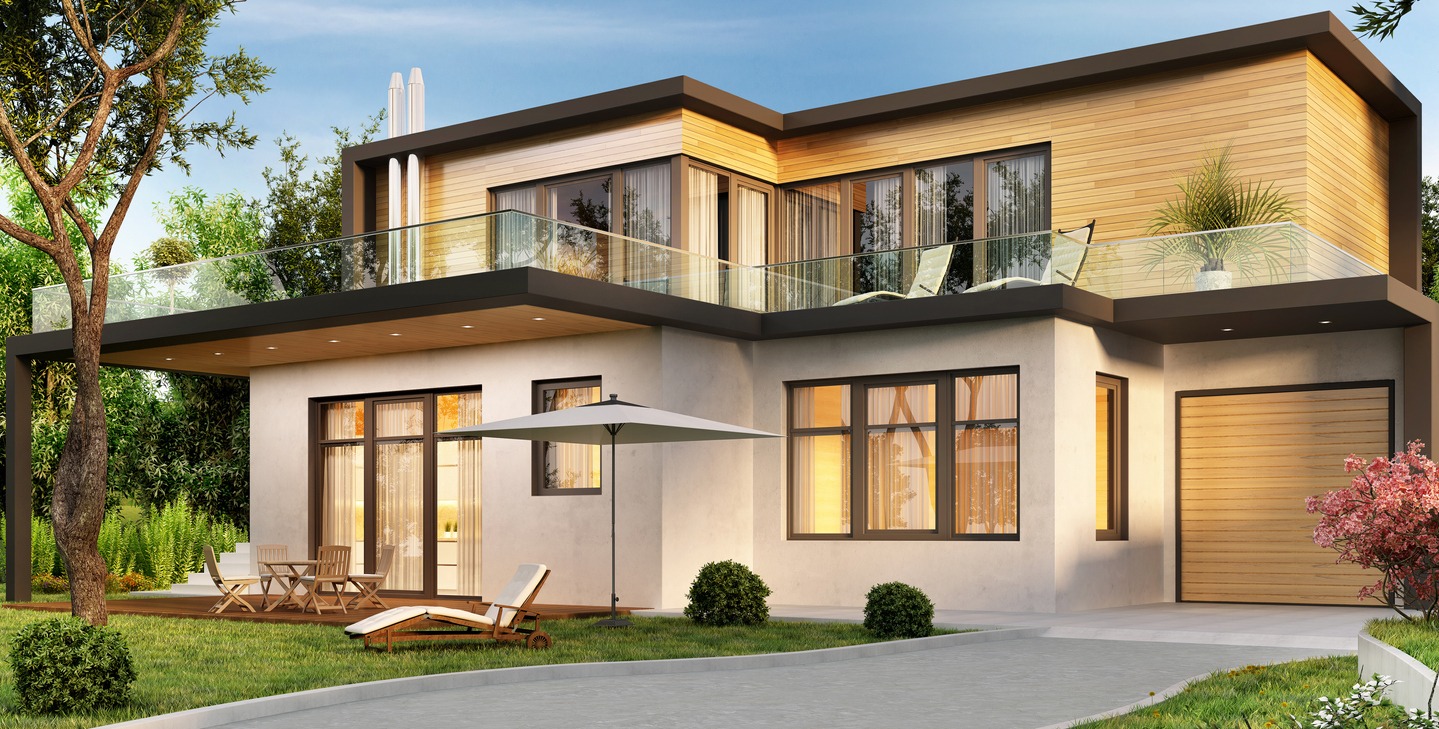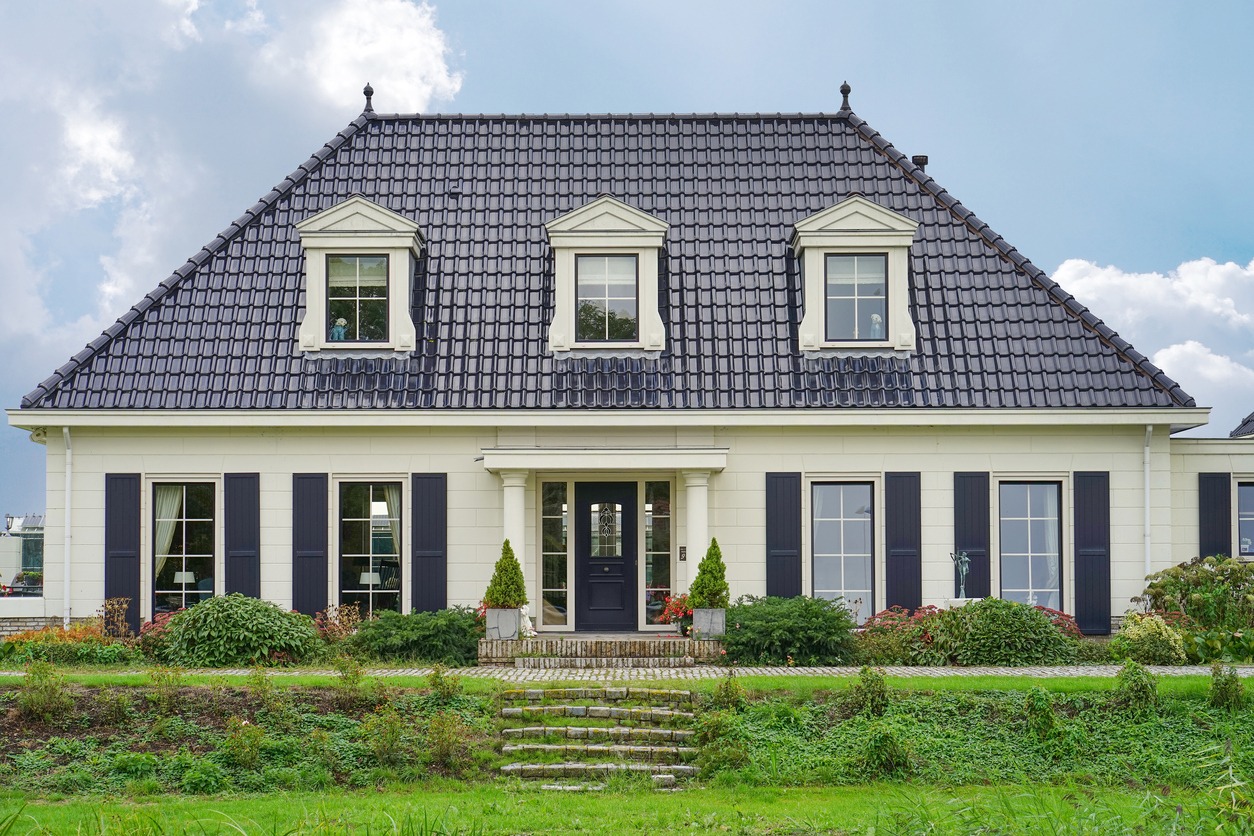Choosing between a pitched roof and a flat roof is a significant decision when it comes to building or renovating your home or commercial space. Each option has its benefits and drawbacks, so let’s simplify things for you. In this article, we’ll outline the differences between pitched and flat roofs and highlight the pros and cons of each. This way, you can make a well-informed choice that aligns with your budget and building goals.
Overview of Flat Roofs
In simple terms, a flat roof is exactly what it sounds like—a level surface. Industry standards define a flat roof as having less than a 2% incline. Flat roofs often find their place in urban settings and contemporary designs, while sloped roofs commonly grace traditional single-family homes. Consequently, the construction of flat roofs differs significantly from that of pitched roofs.
Pros:
1. More energy efficient
In regions with warmer climates, flat roofs can significantly help control utility expenses. While pitched roofs might trap excess heat or allow cooled air to escape, flat roofs provide less overhead room for air to linger.
Also, the U.S. Department of Energy categorizes flat roofs as “cool roofs,” boasting the most expansive potential for a reflective surface. Energy Star also considers flat roofs more energy efficient. Moreover, flat roofs are notably solar-panel friendly, enabling panels to be positioned optimally to capture direct sunlight compared to their sloped counterparts.
2. Versatile
Opting for a flat roof grants you usable roof space beyond the norm. At the very least, it can accommodate vital appliances like air-conditioning units. For those who would want to reduce their energy bills, these roofs provide ample space for solar panels.
Today, many homeowners transform sections of their flat roofs into charming rooftop gardens, patio areas, or convenient roof decks. This additional space not only enhances the aesthetics but also offers extra protection against the elements. Rubber, plastic, and rubber foam are all suitable options for creating a foundation for an outdoor space. A newer roofing material, thermoplastic polyolefin (TPO), excels at reflecting heat off flat roofs and costs between $5,200 and $21,000 to install
3. Allows rooftop planting
Flat roofs also open doors to the concept of a “green roof” or a rooftop garden. These green roofs excel in energy efficiency by shading the roof’s surface and dissipating heat from both the roof and its surroundings. Endorsed by the U.S. Environmental Protection Agency and Energy Star, green roofs combat heat islands in urban areas. Nonetheless, it’s essential to note that the root systems of plants can potentially damage the roof structure if not managed.
4. Lower upfront costs
If budget considerations are influencing your roofing decision, you’ll be pleased to know that flat roofs come with a notably lower installation cost compared to sloped roofs. This is primarily due to its simpler structure and less materials required because of its flat slope.
On average, installing a flat roof ranges from $3,200 to $10,700, which translates to $4 to $13 per square foot. On the other hand, the installation of a sloped roof typically falls between $5,800 and $12,500. The exact costs will depend on your roof’s square footage and the materials you opt for.
5. Easy to install
Flat roofs are quicker and simpler to install than pitched roofs due to their uncomplicated design. This translates to reduced labor and material requirements, ultimately making them a cost-effective choice.
6. Easy to maintain, clean, and inspect
While flat roofs do demand more maintenance, the process is relatively straightforward compared to caring for sloped roofs. They are also easier to inspect. This ease of inspection, cleaning, and repair can save you time and money throughout the roof’s lifespan.
7. Creates a more cohesive space
The pitched roof vs. flat roof debate on space is ongoing, but a flat roof provides a unified, usable space for the entire house. Unlike a pitched roof with a triangular attic, the top floor of a flat-roofed building mirrors the lower floors. This is why flat roofs are ideal for commercial use, accommodating more offices and storage space.
8. Modern-looking
Featuring clean lines and a minimalist allure, flat roofs are often the choice for contemporary-style homes. If you’re aiming for a modern aesthetic, a flat roof perfectly fits the bill.
Cons:
Despite these benefits, it’s essential to be mindful of the downsides of flat roofs. Without proper planning and the right contractor, a flat roof can lead to significant issues, such as:
1. Inadequate drainage
A prominent drawback of flat roofs is their poor drainage. They tend to retain water, which can lead to leaks and water damage. Proper drainage systems are necessary to mitigate this issue.
2. Shorter lifespan
Flat roofs have a shorter life expectancy compared to pitched roofs due to their inferior drainage and susceptibility to water damage. Without proper upkeep and drainage, a flat roof can deteriorate and need repairs or replacement sooner. Typically, flat roofs last around ten years, notably shorter than pitched roofs. This means you might spend more on roofing over the long haul.
3. Limited insulation
Flat roofs typically lack the insulation found in pitched roofs, potentially leading to higher energy bills and decreased comfort levels in your home.
4. Challenging in cold weather
Cold climates pose various challenges for flat roofs. Water accumulation and ice dams can lead to excessive snow and ice buildup. If you’re considering a flat roof in colder regions, consult your builder for weatherproofing and suitable materials.
5. Increased maintenance
Flat roofs bring structural concerns, particularly in areas with heavy snow or rainfall. Regular inspections—preferably at least once a year—are recommended to catch significant issues. Fortunately, flat roofs are easy to inspect as they are walkable, making regular roofer visits budget-friendly.
However, the maintenance expenses of a flat roof accumulate over time and should be taken into account. Immediate attention is needed to address standing water during rain or snow to prevent leaks into your home. Additionally, heavy snow accumulation can lead to leaks, making winter monitoring crucial.
Splitting is a common issue with flat roofs that use materials like asphalt or felt, unlike sloped roofs employing slate or shingles. This occurs when the material separates, potentially causing leaks into your home.
6. Limited aesthetics
While flat roofs can have a modern appeal, they might not suit traditional architectural styles, limiting their aesthetic versatility. The roof itself doesn’t add any curb appeal to the house.
7. There is a greater likelihood of early replacement
While well-maintained sloped roofs can last 20 years or more, flat roofs typically need replacement every decade. According to the National Roofing Contractors Association, many homeowners opt for sloped roofs due to this factor.
8. Green roofing concerns
Transforming a flat roof into a garden space is eco-friendly and visually appealing. However, invasive plant roots can puncture the roof over time, causing leaks. Proper treatment is crucial to prevent this issue.
Overview of Pitched Roofs
A pitched roof is a roof type with an apex or peak. It slopes downward, with two or more sections sloping in opposite directions. This design forms the triangular top of a house and often results in spacious attics. It’s the most prevalent roof style for residential homes.
In most cases, a pitched roof possesses a slope ratio greater than 3:12. The slope is strategically designed to allow water and debris to naturally slide off the roof without intervention. This design offers diverse creative possibilities, each with its own pros and cons.
Pros:
Given the popularity of pitched roofs compared to flat roofs, it’s evident that there are compelling reasons behind homeowners’ and business owners’ preferences. A few perks you can expect from pitched roofs include:
1. Timeless visual appeal
Pitched roofs exude a classic, cozy charm. Unlike flat roofs, which are trendy in modern architecture, pitched roofs impact the building’s appearance. They lend a traditional, timeless look to homes and come in an array of materials, colors, and designs to match any style.
When envisioning an attractive roof, it is likely to have a pitched design. This distinct feature makes it visible from the ground and integrates it into the overall visual appeal. Opting for one can also harmonize your home with the neighborhood.
2. Has a longer lifespan
Pitched roofs offer a major benefit in their extended lifespan. Ten years is relatively short for a pitched roof’s life; with high-quality materials, it can endure for over a century.
Depending on materials and climate, a sloped roof can serve you well for 30 to 50 years. This stands in contrast to the maximum 12 to 15 years that a flat roof typically offers. Gravity works harmoniously with the roof, reducing stress over time. Pitched roofs are strategically designed to guide rainwater away from the roof, preventing pooling and potential harm to your home’s structure.
3. Better for snowy regions
Flat roofs tend to gather rain and snow, risking pooling and ice dams—a ridge of ice preventing drainage. If not addressed within 48 hours, leaks and structural damage can result. Sloped roofs enable natural water runoff and reduce the likelihood of ice dams.
4. Needs less upkeep
Since sloped roofs don’t retain water as flat roofs do, they generally require less maintenance. Replacing shingles on a sloped roof is simpler compared to repairing flat roof membranes. Flat roofs demand a sealed barrier to fend off moisture, necessitating maintenance for proper functionality.
5. Less frequent leaks
Pitched roofs experience fewer leaks. When a breach occurs, you can often fix the affected area without extensive repairs.
6. Require fewer inspections
While both flat and sloped roofs should undergo annual inspections, flat roofs’ lifespan concerns may prompt more frequent checks. If you notice standing water, a swift inspection is vital to address the issue before it escalates. Sloped roofs, although still needing regular checks, tend to encounter fewer structural problems than flat roofs.
Cons:
Pitched roofs also come with their downsides. Some of the main ones include:
1. Higher upfront expenses
Installing a pitched roof can incur higher costs compared to flat roofs, primarily due to the increased materials, complexity, and labor needed. It also requires more skill and experience to install than flat roofs.
2. More prone to wear and tear
Over time, sloped roofs can be more prone to aging and weathering from wind, rain, and other conditions due to their exposure to the elements.
3. Less modern aesthetic
For those envisioning a sleek, modern home or building design, a pitched roof might not align with the architectural style sought after. A flat roof could offer a more cohesive appearance, blending seamlessly with the overall building design.
4. Challenging to work on
In addition, working on pitched roofs is more challenging. The incline, especially if it’s steep, leads to difficulty and hazards. Depending on the material, standing safely on it might not be feasible. Although pitched roofs generally entail less maintenance, the upkeep can prove more intricate and costly.
5. Reduced usable space
The angle of a sloped roof limits the usable space under the roof, making it less suitable for rooftop installations like gardens or solar panels.
How to Choose Between a Flat Roof and a Pitched Roof
When considering whether to go for a pitched roof or a flat roof, your personal preference plays a crucial role. Pitched roofs are known for their durability and lower maintenance requirements, making them a long-term value proposition. On the other hand, if you’re drawn to the appearance of flat roofs and want a cost-effective installation, a flat roof is a viable choice.
To make an informed decision, focus on the following factors:
- The type and style of your home or commercial building
- Your budget for the initial roof installation and ongoing maintenance
- How much effort you’re willing to invest in roof upkeep over time
- Continue reading to get a comprehensive breakdown of the factors to consider in your decision.
Think about utilizing Interior Space
While deliberating between a flat roof and a sloped roof, remember to factor in the space just underneath the roof inside your building. Do you make full use of this area, and could extra space right below the roof be beneficial? Opting for a flat roof can provide extra space, allowing you to stack supplies, shelves, or equipment higher than you could with a sloped roof. If you plan on maximizing vertical space in your building, a flat roof can be a game-changer.
Take roof size into account
In practice, roofs are often sizeable. If you go with a sloped roof, your roof might feature a tall peak or a series of peaks and valleys. Typically, smaller buildings are better suited for sloped roofs, while larger structures tend to favor flat roofs.
Compare costs
When it comes to expenses, flat roofs generally come with a higher price tag compared to sloped roofs. Flat roofing involves additional steps, often requiring insulation installation. If you’re seeking a robust yet cost-effective roofing solution, a sloped roof is likely the smarter choice. But if you’re willing to invest a bit more for a roof that can endure the elements and provide extra space beneath it, a flat roof could be your better fit.
Consider its lifespan
Sloped roofs tend to have longer lifespans than flat roofs. There are several reasons for this. Sloped roofs can be crafted from a wider range of materials, such as shingles, concrete, and wood shingles. Additionally, the steeper slope helps sloped roofs shed water, ice, and snow more effectively, which contributes to their durability compared to the flatter profile of flat roofs.
Consider energy efficiency
While sloped roofs boast cost-effectiveness and durability, flat roofs have a special affinity for solar panels. Placing solar panels on flat roofs can maximize their exposure to direct sunlight. Moreover, flat roofs are better suited for accommodating air conditioners and large appliances needed for your business. Keeping appliances on the roof rather than inside the building can reduce indoor noise and free up space for other equipment or storage needs.
Conclusion
When faced with the choice between a flat roof and a pitched roof, your priorities matter. Factors such as cost, durability, and aesthetics should all be weighed. Don’t forget to factor in your region’s climate, as certain roof types perform better under specific weather conditions. Ultimately, the decision rests on your personal preferences and practical needs.


